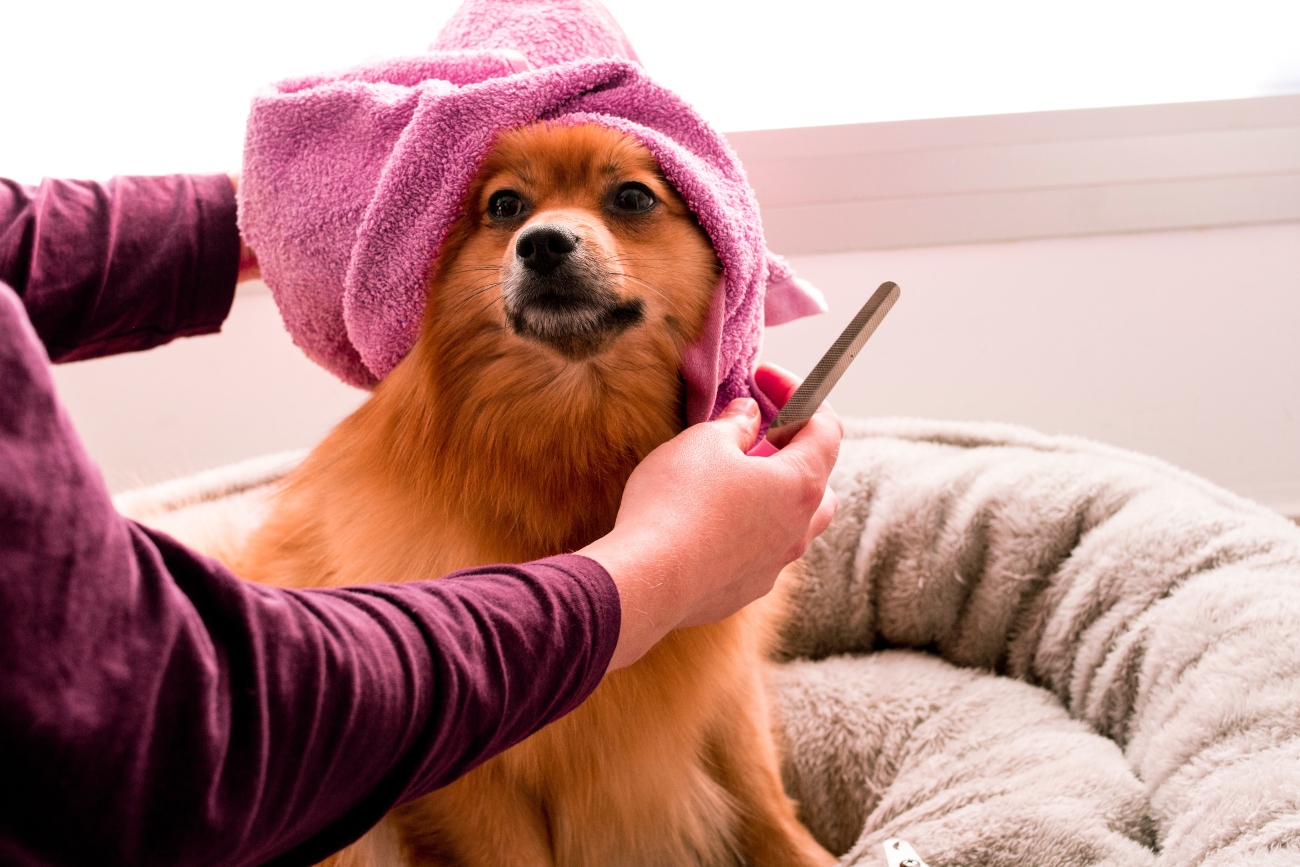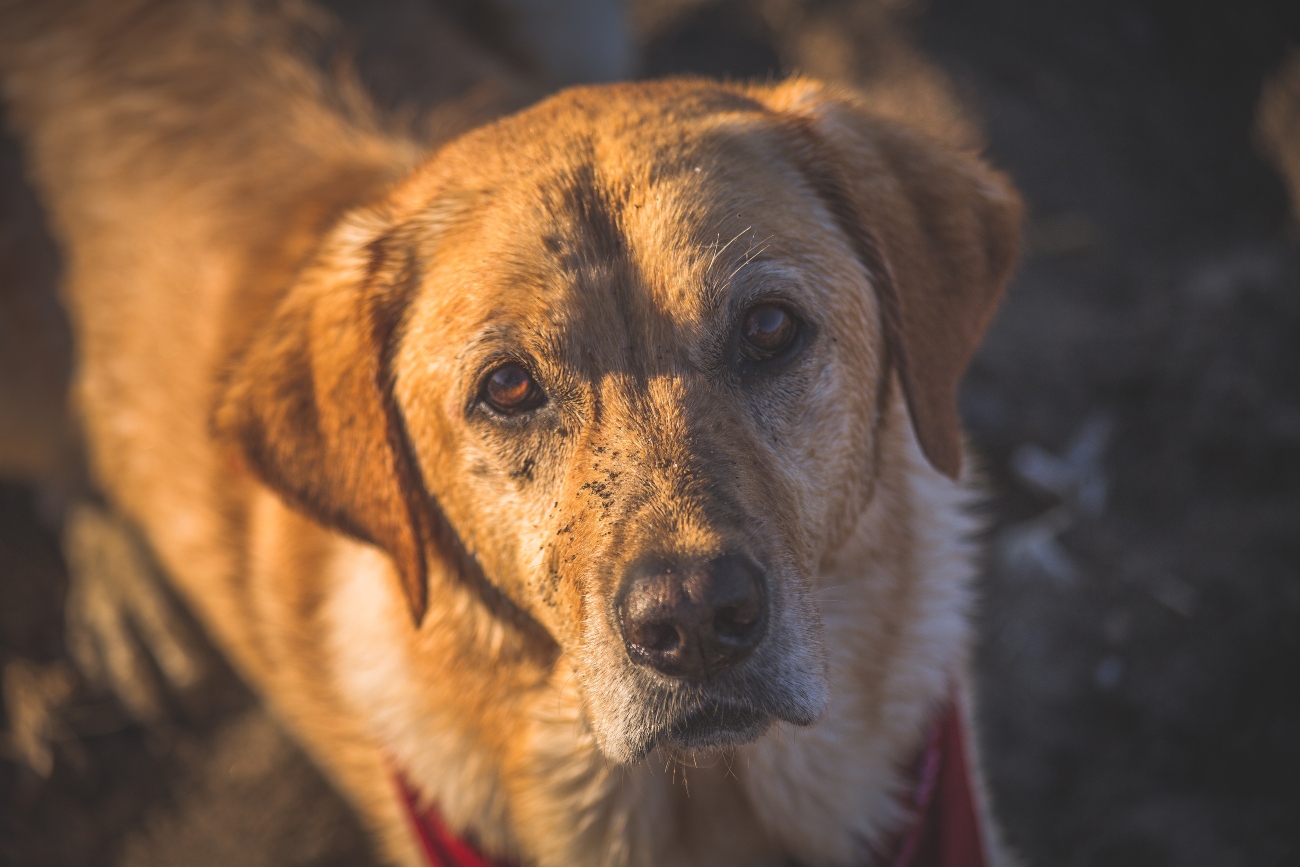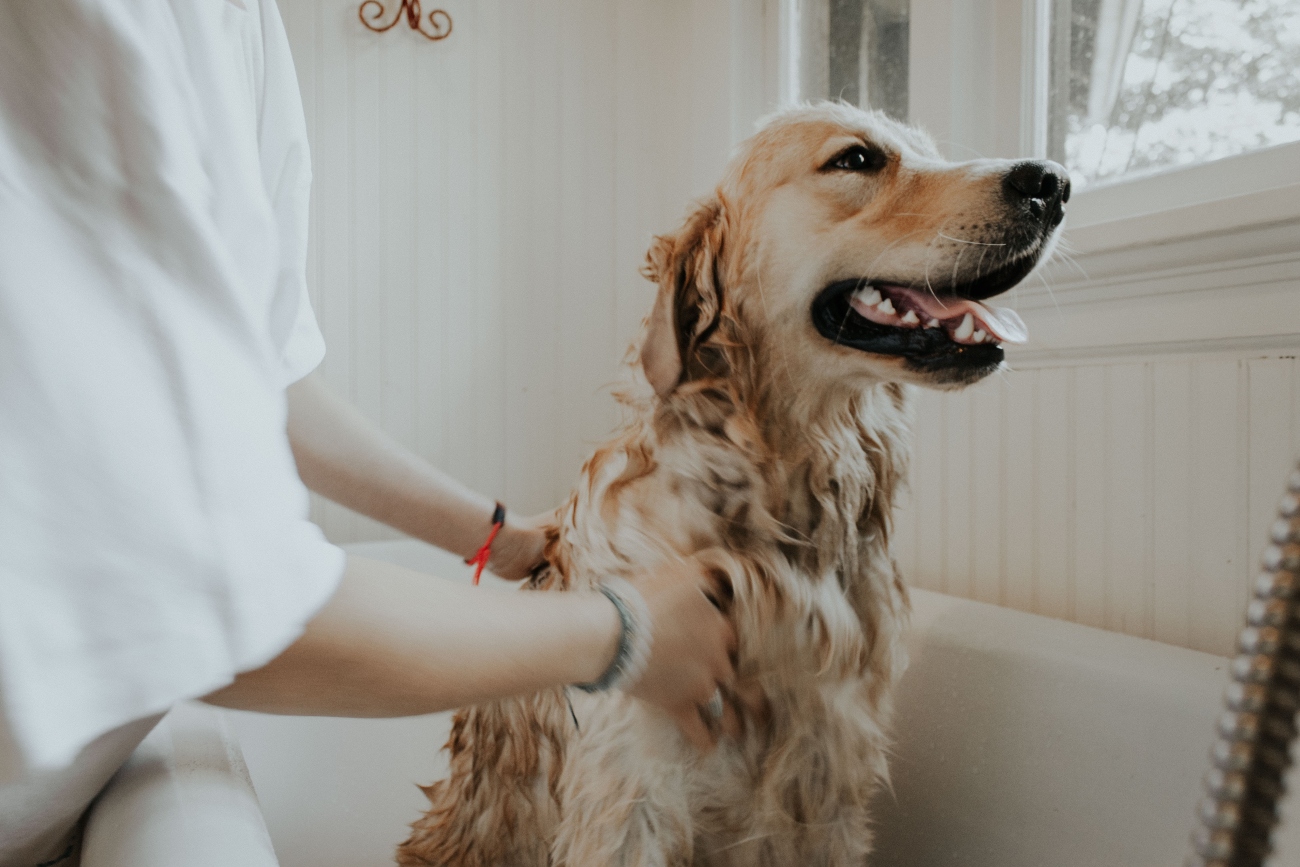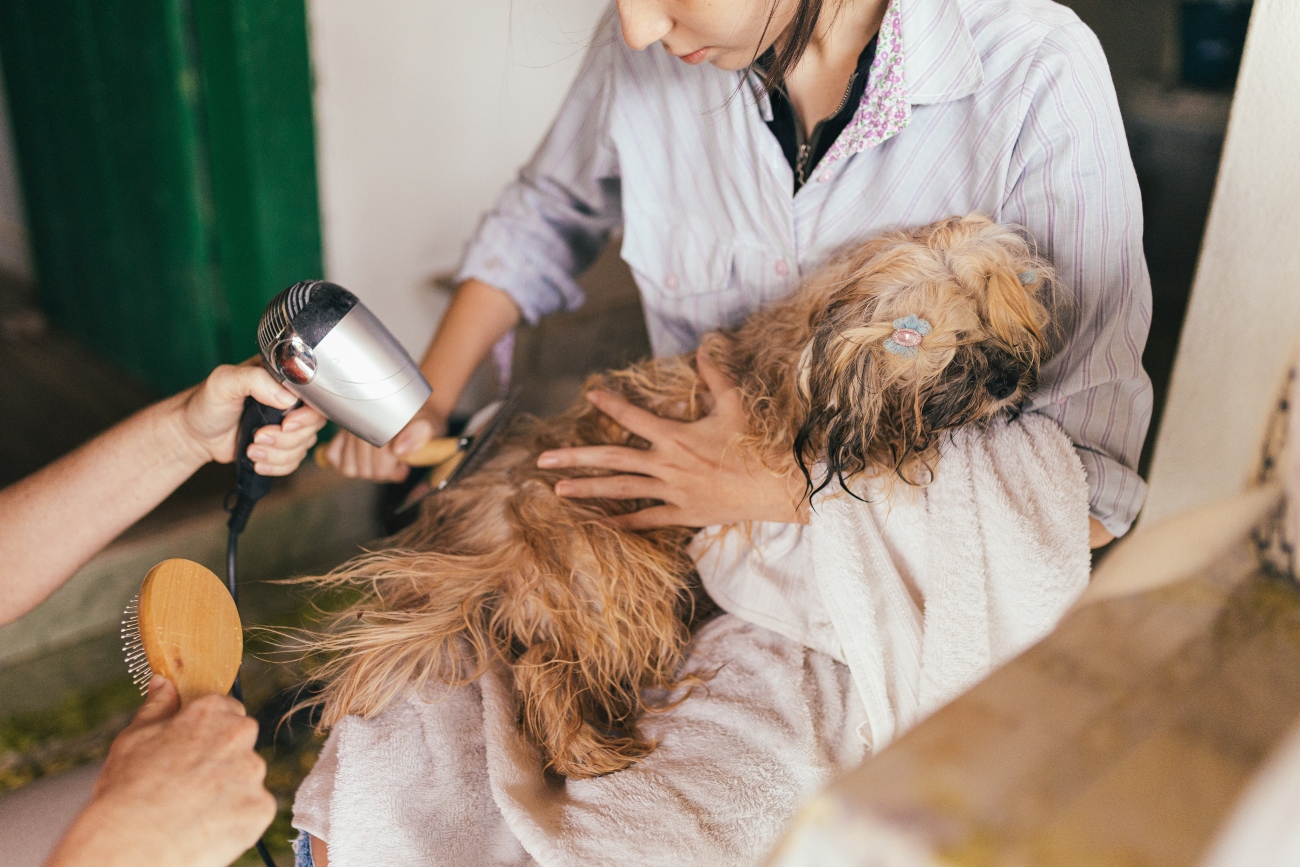
How to bathe an older dog
6th October, 2021
As your dog gets older, they will need more loving care. You might need to change a few things to accommodate their reduced mobility, including their bathing routine.
Older dogs might find it harder to clean themselves as well as they once did. Arthritis or painful joints might mean they can no longer get to those hard-to-reach places and they’ll need your help.
You may have to increase your grooming sessions. Not only will this help you spot any new lumps and bumps that start appearing, it will also help to keep that old dog smell at bay! And of course it will help strengthen the bond between you even further.
But the benefits of regular baths don't end there. They will also help to keep your dog's fur healthy, and will help to clear away any skin infections. Lastly, regular washes will also get rid of any small pests, such as ticks and fleas, that may be clinging on to your dog's fur.
Another way in which you may want to provide that extra bit of care for your older dog is by taking out some specialist older dog insurance. This can help with some of the medical bills that may come your way as you seek to provide your beloved companion with a happy and comfortable life in old age.
So what’s the best way to bathe your dog – especially an older animal who will be fully grown and, quite possibly, not as agile as they once were?
Getting a routine going
It's really important, for the reasons we mentioned above, to keep your dog clean so make sure bath time is a regular part of their life, rather than an occasional event.
Some dogs may really enjoy getting wet (breeds that are known to love water include Newfoundlands, Irish Water Spaniels, and Labrador Retrievers). Others may prove far more reluctant to get in the water. Size will also be a factor – a larger and/or less mobile dog will take more effort to get into the bath. Either way, though, you should make baths a frequent date in the diary.
If you get a regular bath time schedule up and running, your dog will get to know how often this happens – and what to expect. We'd recommend a full doggy wash at least once a week. Some dogs, however, may require more regular bathing – especially those that just love to get messy or who may be struggling with incontinence.

Make space for bath time
Bathing a dog can be a fairly space-intensive process. You will need the use of a whole room – and, obviously, a bathroom with its own bathtub will work best. If you don't have a bathtub, your next best bet is to buy a large plastic water tank, and give your dog their regular baths either in the bathroom or in another area of the house that can cope with getting wet – the basement, say, or the garage.
Wherever you choose, you should be able to close all doors into the room. Dogs can get easily distracted, or may do just about anything to avoid bath time, so you'll want to be able to keep them in the room for the duration.
Get the bath area ready
Baths will go so much more smoothly if you make a few quick, easy preparations before you begin. For example, be sure to place a non-slip mat on the bottom of the bathtub or tank before you fill it up with water. This will help to prevent your dog from slipping and sliding around in the tub while you wash them and potentially causing themselves an injury, which could see you claiming on your older dog insurance.
It's also a good idea to have some large towels or water-absorbent mats all around the bath, to soak up any water that splashes out.
Ensure you're wearing the best clothes for the job, too. These should be nice and loose to allow you to move around easily: you will find that keeping your dog in one place while you bathe them can be quite a physical job! It may need two of you if your own mobility isn’t that great, either.
Get the right products
Whether or not your dog actually enjoys the weekly bath, or protests and splashes about a lot, will largely depend on each animal's personality. However, there are a few things you can do to make the whole process smoother and less stressful for you both.
For one thing, choose a really good dog shampoo and conditioner blend. You want to look for a product that will cleanse your pet's fur and protect your pet from parasites.
A moisturising shampoo is also a good idea, as it will help prevent fur from drying out. And we recommend an all-in-one shampoo and conditioner rather than two separate products, as this will make the whole process run much more quickly.
This is another of those cases – like the careful selection of senior dog insurance – where taking a little time to get the right product can make all the difference.
What about the temperature?
Dogs' skin is sensitive to temperature – more so than ours, in fact – so water that is either too cold or too hot will upset them. In particular, a bath that's too warm can be bad news for an older dog as it increases heart rate and can put unwanted strain on their heart. Instead, aim for a lukewarm temperature – about 37 degrees Celsius, if you have a thermometer to hand.
You should fill your bath or container until it's roughly half full, and then bring your dog into the room and close the door. Now, before you introduce your dog to the water, it's a good idea to give them a relaxing massage and a gentle brush of their coat. This will get them nicely relaxed so that their immersion in the bath doesn't come as too much of a shock.
We've got some more detailed advice on how to massage your senior dog elsewhere on our blog.
Give plenty of help and reassurance
When it comes to getting your dog in the water, they may well be a little reluctant. Gentle coaxing, rather than force, is the way forward here. It may help to find one of their favourite toys and throw it into the bath to keep their interest.
Depending on the state of their sight and their joints, your dog may need some assistance getting into the bath. If so, remember to bend your knees and lift with your legs not your back, especially if they’re a larger breed. There are baths with steps available online, or even doggy hoists which may help make the process easier.
Once your dog is safely in the water, be very aware of their mood. They may seem quite happy, or rather anxious. If the latter, make sure your speech and movements are gentle and soothing: talk to them softly and encouragingly while you get them wet and work the shampoo into their fur.
Dogs are sensitive creatures and will pick up on your mood: if you can project an atmosphere of calm and encouragement, it will help them to settle into bath time that much better. If your older dog is struggling with their eyesight, your calming voice will reassure them, too.

Be careful around the eyes
When you come to wash your dog's face and head, try to avoid getting any soap suds into their eyes. You'll know from your own experience that this can be painful, and it can be all the more alarming for dogs as they are not expecting the sensation and don't know where it's come from. As well as wiping gently around the eyes, be sure to clean out your dog's ears carefully.
This part of the washing procedure can be tricky, so you may want to ask a family member for help. Generally, dogs won't enjoy having their head washed so it's a good idea to get this part of the wash over as quickly as possible, while continuing to soothe and relax your pet.
Time to rinse and dry
When you are satisfied that you have thoroughly soaped and scrubbed your dog and they are looking lovely and clean, it's time to let out the soapy water and replace it with some lovely clean, warm water. You can use this to give your dog a thorough rinse and to get those soap suds off their body. Make sure all the suds have gone as they could cause irritation if not.
If you want to give the rinsing process an extra health-giving kick, you could think about adding, into the rinsing water, a few drops of any essential oil with antiseptic properties. Tea tree, eucalyptus or rosemary will all do a great job here. You only need a few drops: and the result should keep the fleas and other little pests away, as well as giving your dog a lovely fresh scent.
When your pup is thoroughly rinsed, it's time to get dry! This part is reasonably simple: just wrap them in a nice warm towel, holding them against yourself to let all the excess water soak through. You can then use a hair dryer to blow dry the rest of the moisture from their coat: just be sure to use a low heat setting. You want to make sure your dog gets thoroughly dry after bath time, as they may risk catching a cold if still damp.

How to get your old dog to love bath time
As we mentioned above, dog breeds vary in how much they like being in water, and your dog's own personality and past experience with water will also impact on how much they enjoy – or really don't enjoy – getting wet.
Some dogs will take an extreme aversion to having a bath. Here are a few more things you can try in order to make the weekly wash more acceptable:
1. Walk first, bath later
If your dog is just back from a walk, a nice cool bath is likely to seem that bit more attractive. They will also be tired from the walk so will probably put up less of a fight!
2. Make it fun
If your dog isn't enjoying their weekly wash, you're probably not either – and before you know, an atmosphere of stress and tension can descend on you both whenever it's that time of the week. That's likely to just make the whole thing even harder. So why not change the feel of bath time, and make it seem like another playtime session?
3. Get help from a happier bather
You'll often find, as a dog owner, that the best teacher for a certain skill will be another dog. And this could well be the case here, too: if your pet enjoys the company of other dogs, or has a particular special friend around whom they're always at ease, why not invite a canine companion over to share a bath? If your dog sees their friend having a great time in the water, they may learn to unwind, relax and enjoy themselves, too.
4. Take small steps
If your dog is finding the whole notion of bath time a bit alarming, it may be time to break it down into smaller parts and introduce them more gradually. So, for example, get them used to – and comfortable with – the sound of running water at first.
Then you can let them watch while you fill the bath. Maybe get their feet wet… then their legs. You don't have to be getting full bath sessions in from the beginning: it's more about making them comfortable around water. A little at a time may make the whole idea much more palatable than a whole lot of water at once.
Older dog insurance from Petwise
Here at Petwise, we take the welfare of older dogs very seriously. That's why we're proud to offer various levels of older pet insurance. Benefits can include:
- 24-Hour Vet Helpline
- Senior food contribution
- Dental cover as standard
Get in touch with us to find out more about older dog insurance today.
Policy benefits, features and discounts offered may very between insurance schemes or cover selected and are subject to underwriting criteria. Information contained within this article is accurate at the time of publishing but may be subject to change.